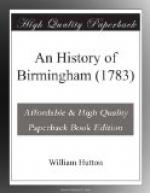During Cromwell’s government, —— Slater, a broken apothecary of this place, having been unsuccessful in curing the body, resolved to attempt curing the soul. He therefore, to repair his misfortunes, assumed the clerical character, and cast an eye on the rectory of St. Martin’s; but he had many powerful opponents: among others were Jennens, an iron-master, possessor of Aston-furnace; Smallbroke, another wealthy inhabitant, and Sir Thomas Holt.
However, he with difficulty, triumphed over his enemies, stept into the pulpit, and held the rectory till the restoration.
Being determined, in his first sermon, to lash his enemies with the whip of those times, he told his people, “The Lord had carried him through many troubles; for he had passed, like Shadrach, Meshach, and Abednego, through the fiery furnace. And as the Lord had enabled the children of Israel to pass over the Red Sea, so he had assisted him in passing over the Small-brooks, and to overcome the strong Holts of sin and satan.”
At the restoration, suspecting the approach of the proper officers to expel him from the Parsonage-house, he crept into a hiding-place under the stairs; but, being discovered, was drawn out by force, and the place ever after, bore the name of Slater’s Hole.
John Riland succeeded him, who is celebrated for piety, learning, and a steady adherence to the interest of Charles the First; in whose cause he seems to have lost every thing he possessed, but his life. He was remarkable for compromising quarrels among his neighbours, often at an expence to himself; also for constantly carrying a charity box, to relieve the distress of others; and, though robbed of all himself, never thought he was poor, except when his box was empty.—He died in 1672, aged 53.
A succeeding rector, William Daggett, is said to have understood the art of boxing, better than that of preaching: his clerk often felt the weightier argument of his hand. Meeting a quaker, whose profession, then in infancy, did not stand high in esteem, he offered some insults, which the other resenting, told him, “If he was not protected by his cloth, he would make him repent the indignity.” Dagget immediately stripped, “There, now I have thrown off my protection.”
They fought—but the spiritual bruiser proved too hard for the injured quaker.
Among the rectors we sometimes behold a magistrate; at others, those who for misconduct ought to have been taken before one.
The rectory, in the King’s books, was valued, in 1291, at 5_l_. per annum; and, in 1536, at 19_l_. 3s. 6d.
A terrier of the rectory, written by the rector, about 1680.
A house wherein the present rector, Mr. Dagget, resides. [Parsonage-house.]
Two other houses in Birmingham, [now three, at No. 15, Spiceal-street.]
Three pieces of glebe land, nineteen acres, between the school land and Sheepcoat-lane.




